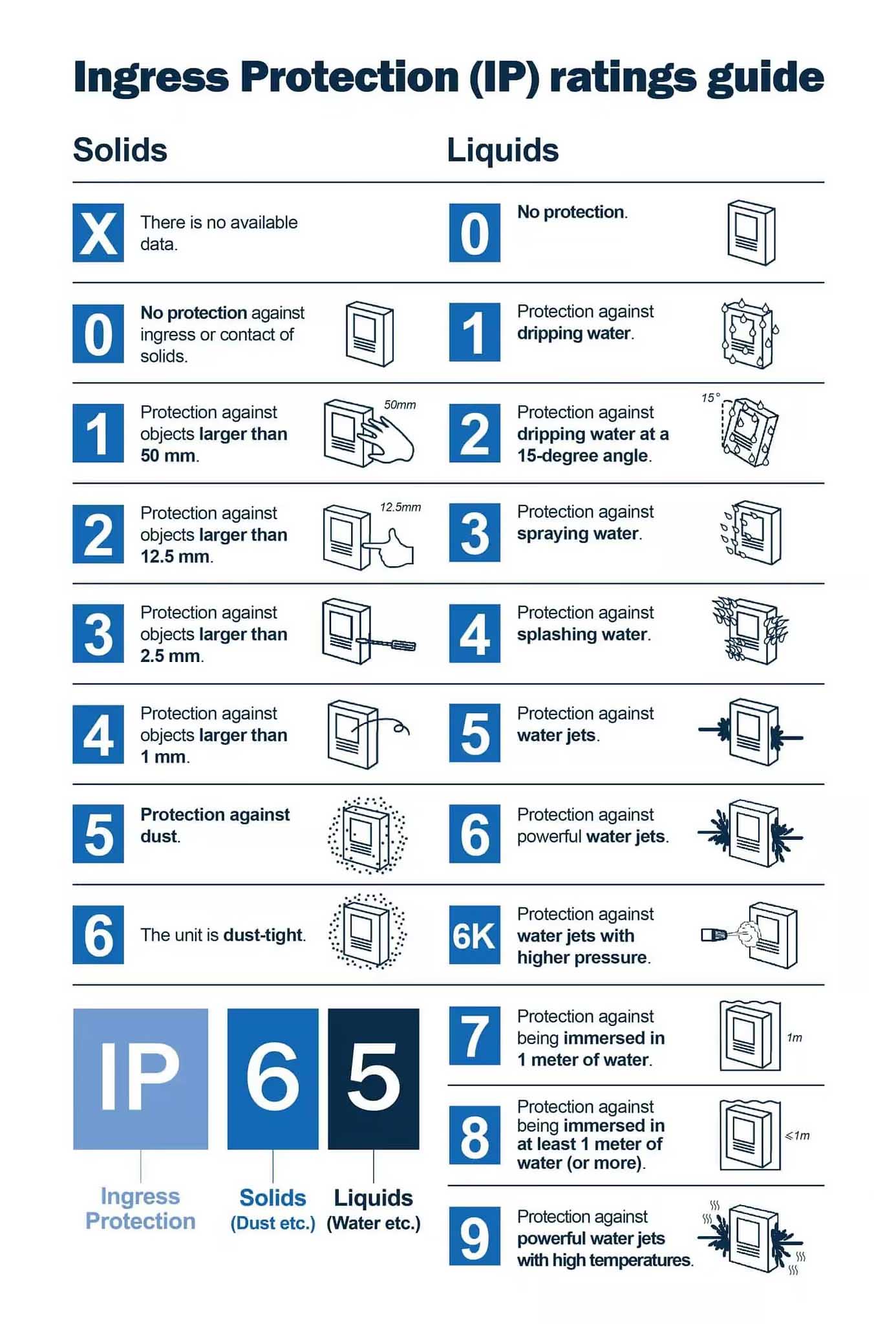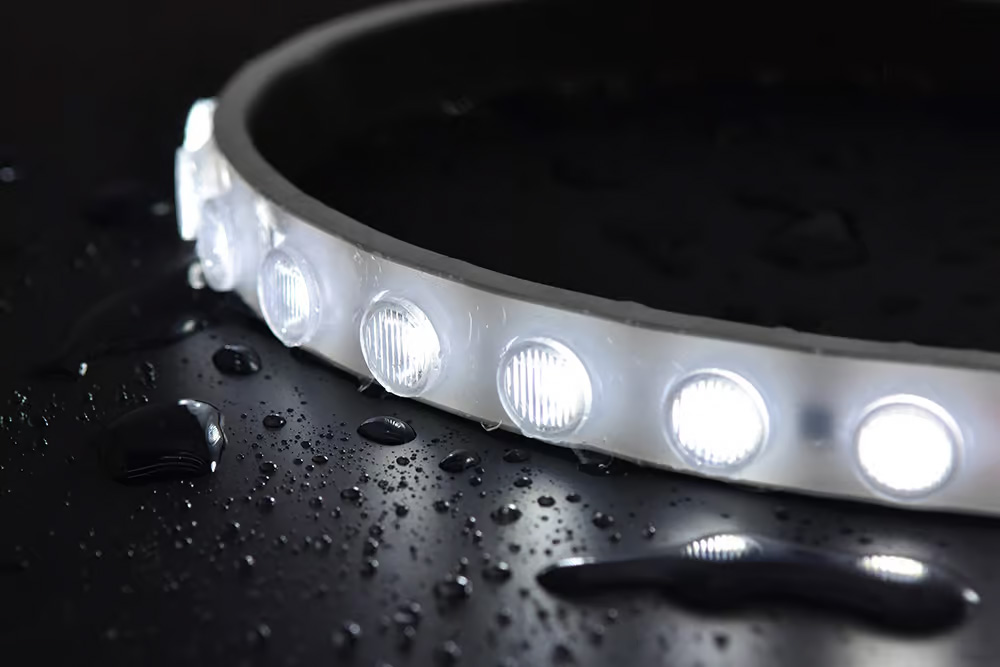IP Ratings: The Definitive Guide
Manufacturers often use the terms "dustproof" or "waterproof" to describe the ruggedness of their products. But such a statement does not provide adequate justification for the scope of protection. Therefore, to clarify and strengthen such claims, they use IP ratings to define the resistance level of their products. But what does IP rating mean?
The degree of protection or IP rating is a rating system defined by the international standard EN 60529 that measures the degree of protection of any electrical equipment against foreign objects (dust, wires, etc.) and moisture (water). It is a two-digit rating system where the first number indicates protection against solids and the second number indicates protection against liquids.
IP rating is an important factor when purchasing electronic equipment, including light fixtures or LED strips. So here I provide a detailed guide on the various IP classes and their suitable uses
What is IPX rating?
The letter "X" in the IP rating indicates that the device is not rated for any specific level of protection. So, for example, if If it replaces the second digit, the machine has no liquid ingress protection rating.
IPX6 therefore means that an object is resistant to water spray, but no testing has been done to clarify the rating for solid contact. And IP6X indicates exactly the opposite; it's safe for solid ingress, but there's no information about waterproofing.

IP rating comparison table
The table below shows the comparison between solid and liquid intrusion protection levels (first and second place)
| first digit | Rugged protection level | second digit | Liquid ingress protection |
| 0 | no protection | 0 | no protection |
| 1 | Protects against solids larger than 50 mm in diameter | 1 | Prevent vertical dripping |
| 2 | Protection against objects larger than 12mm; fingers or similar objects | 2 | Prevents vertical dripping at an angle of 15 degrees from normal position |
| 3 | Prevents objects larger than 2.5 mm in diameter from entering | 3 | Spray protection up to 60 degrees in vertical position |
| 4 | Protects against solid objects larger than 1mm | 4 | Irrespective of any direction and protected from splashing weather |
| 5 | Partially dustproof | 5 | Low pressure section water jet protection |
| 6 | Completely dustproof | 6 | Protect against strong water jets. |
| none | 6K | High pressure water jet protection | |
| none | 7 | 1m water immersion protection; test duration is 30 minutes. | |
| none | 8 | Long term water immersion protection | |
| none | 9 | Protection against high temperatures, high water pressure and water flow |
light level
The light fixture has an IP rating to protect it from dust and water. So, for example, when installing lights outdoors, you must ensure that they are dust and water-resistant and can withstand rain and other extreme weather conditions. But again, when you need indoor lighting, it doesn't need to be waterproof. Therefore, the IP rating of lights will vary depending on the purpose and atmosphere in which they are used. Here are some ideal ratings for different lighting purposes-
| IP rating | suitable environment | Type of light |
| IP20 and IP40 | Indoors (relatively neutral environment) | LED line lights, LED light bars , etc. |
| IP54 | Indoor (partially dustproof and waterproof) | Bollard Lights, indoor LED lights, etc. |
| IP65 | Outdoor (dustproof, rainproof) | Wall washers, flexible wall washers , lamp posts, LED light strips , etc. |
| IP67 and IP68 | Outdoor (submersible; suitable for pool or fountain lighting) | LED light strips , floodlights, etc. |
Which is better: IP44 or IP65?
Products with IP44 and IP65 ratings ensure protection from user access, touch, wires, tools, etc. But which one is better? Let’s compare them to find the better one –
- IP65 ensures proper protection against dust. However, IP44 lamps are not dustproof. As a result, dust can get into the casing and damage the item.
- IP44 cannot withstand water spray. In contrast, IP65 provides water spray protection at low pressures.
So, comparing these two ratings, we find that IP65 is better as it provides higher protection than IP44.
Which is better: IP55 or IP65?
IP55 and IP65 provide the same degree of protection against liquid intrusion. Therefore, water jets from any direction will not damage products with these IP ratings. But they differ in terms of solid entrance protection.
IP55 partially dustproof. That said, there is the potential for dust to accumulate. In contrast, IP65 ensures complete dust protection. Therefore, IP65 is better than IP55.
Which is better: IP55 or IP66?
IP55 and IP66 have varying degrees of protection against solid and liquid intrusion. Let’s compare these two ratings to find the better one –
- IP55 dustproof but not complete; may accumulate dust. But IP66 is dustproof. Therefore, no dust can enter the housing with IP66 protection rating.
- In terms of liquid ingress, IP66 is safer than IP55. IP66 can resist stronger water jets than IP55.
- IP55 withstands water pressure of 30 kPa and water volume of 12.5 l/min. In comparison, IP66 can withstand water pressures up to 100 l/min at 100 kPa.
Therefore, IP66 provides better protection against the ingress of solids and liquids than IP55.
Which is better: IP55 or IPX4?
Choose the better one between IP55 and IPX4 with the following comparison-
- The letter "X" in the IPX4 rating indicates that the product/fixture is not rated for any specific level of protection against solid intrusion. In contrast, IP55 ensures protection against the ingress of solids (dust protection). Therefore, IP55 is a safer choice than IPX4.
- IP55 resistant to water spray from all directions. Meanwhile, IPX4 is splash-proof and cannot withstand water jets.
Therefore, to protect against the ingress of solids and liquids, IP55 is a better choice than IPX4.
Which is better: IP67 or IP68?
You should first understand the similarities and differences between IP67 and IP68 in order to find a better one. These are as follows-
Similarities between IP67 and IP68
- Great for outdoor use
- Provides rugged protection against dust
- Both can be submersed in water up to 1 meter deep.
Difference between IP67 and IP68
- IP67 is waterproof (can prevent water ingress to a certain extent, but not completely). In contrast, IP68 is waterproof (completely waterproof; water cannot get in).
- Products with an IP67 rating can be immersed in water to a depth of 1m and withstand only 30 minutes. Meanwhile, IP68 allows products/fixtures to be immersed to more than 1m for more than 30 minutes, according to the manufacturer's specifications.
After analyzing the similarities and differences between IP67 and 68, I found that IP68 is better than IP67.
Is IP69 better than IP68?
IP68 and IP69 have the same level of protection against solid intrusion. But when it comes to keeping liquids out, the difference is noticeable.
IP69 resistant to high temperature, high pressure and erosion. Therefore, they are ideal for projects that require a high degree of disinfection and must withstand high pressure and hot water cleaning. For example, pharmaceutical applications, chemical manufacturing, food and beverage processing, etc. use IP69 rated equipment.
In contrast, IP68 ensures the ability of an object to sustain immersion under conditions specified by the manufacturer. They can withstand water to 1m or deeper for 30 minutes or more.
Although IP969 is the highest level of protection against liquid ingress, it is generally considered overkill for most applications. IP68, on the other hand, is the most commonly used IP rating for general use. Such as rated lights and LED strips; use IP68 instead of IP69. In contrast, IP69 is used for items that need to be rinsed frequently under high water pressure. Therefore, when choosing the better one between IP69 and IP68, you must consider the intention of use.
Is a higher IP rating better?
A higher IP rating means better protection against the ingress of solids and liquids. Therefore, LED strips/devices with high IP ratings can withstand harsh weather conditions such as heavy rain, storms, and dust. That’s why you can use them anywhere without worrying about damage from bad weather. Additionally, the higher IP rating - IP68 can be submerged in water. Therefore, you can use LED light strips with this rating to light up musical fountains, swimming pools, bathtubs, etc.
On the other hand, the lower IP rating does not support complete dust and water resistance. Therefore, they are not suitable for harsh weather conditions or outdoors.
All in all, a higher IP rating provides better security, which is why it is a better choice.
common problem
The IP68 is waterproof, ensuring complete protection against water ingress. In addition, it can be submerged in 1 meter (or deeper) of water for 30 minutes (or longer depending on the manufacturer's specifications). This is why the IP68 is suitable for swimming.

